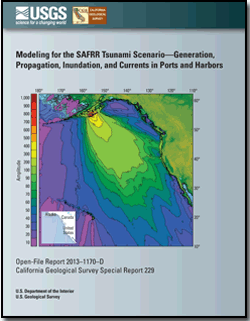 Preface Preface
This U.S. Geological Survey (USGS) Open-File report presents a compilation of tsunami modeling studies for the Science Application for Risk Reduction (SAFRR) tsunami scenario. These modeling studies are based on an earthquake source specified by the SAFRR tsunami source working group (Kirby and others, 2013). The modeling studies in this report are organized into three groups. The first group relates to tsunami generation. The effects that source discretization and horizontal displacement have on tsunami initial conditions are examined in section 1 (Whitmore and others). In section 2 (Ryan and others), dynamic earthquake rupture models are explored in modeling tsunami generation. These models calculate slip distribution and vertical displacement of the seafloor as a result of realistic fault friction, physical properties of rocks surrounding the fault, and dynamic stresses resolved on the fault.
The second group of papers relates to tsunami propagation and inundation modeling. Section 3 (Thio) presents a modeling study for the entire California coast that includes runup and inundation modeling where there is significant exposure and estimates of maximum velocity and momentum flux at the shoreline. In section 4 (Borrero and others), modeling of tsunami propagation and high-resolution inundation of critical locations in southern California is performed using the National Oceanic and Atmospheric Administration’s (NOAA) Method of Splitting Tsunami (MOST) model and NOAA’s Community Model Interface for Tsunamis (ComMIT) modeling tool. Adjustments to the inundation line owing to fine-scale structures such as levees are described in section 5 (Wilson).
The third group of papers relates to modeling of hydrodynamics in ports and harbors. Section 6 (Nicolsky and Suleimani) presents results of the model used at the Alaska Earthquake Information Center for the Ports of Los Angeles and Long Beach, as well as synthetic time series of the modeled tsunami for other selected locales in southern California. Importantly, section 6 provides a comparison of the effect of including horizontal displacements at the source described in section 1 and differences in bottom friction on wave heights and inundation in the Ports of Los Angeles and Long Beach. Modeling described in section 7 (Lynett and Son) uses a higher order physical model to determine variations of currents during the tsunami and complex flow structures such as jets and eddies. Section 7 also uses sediment transport models to estimate scour and deposition of sediment in ports and harbors—a significant effect that was observed in southern California following the 2011 Tohoku tsunami. Together, all of the sections in this report form the basis for damage, impact, and emergency preparedness aspects of the SAFRR tsunami scenario.
Three sections of this report independently calculate wave height and inundation results using the source specified by Kirby and others (2013). Refer to figure 29 in section 3, figure 52 in section 4, and figure 62 in section 6. All of these results are relative to a mean high water (MHW) vertical datum. Slight differences in the results are observed in East Basin of the Port of Los Angeles, Alamitos Bay, and the Seal Beach National Wildlife Refuge. However, given that these three modeling efforts involved different implementations of the source, different numerical wave propagation and runup models, and slight differences in the digital elevation models (DEMs), the similarity among the results is remarkable.
|
First posted September 3, 2013
This report is presented in Portable Document Format (PDF); the latest version of Adobe Reader or similar software is required to view it. Download the latest version of Adobe Reader, free of charge. |